A NASA study has traced a decade of ammonia air pollution in concentrated areas in Africa. Ammonia (NH3) is a colorless gas with a pungent smell composed of nitrogen and hydrogen that can cause heart and lung-related illnesses.
The study, published on Tuesday in the European Geosciences Union, reports that ammonia's presence can make soil more acidic and negatively affect the growth of plants.
NASA researchers used satellite data to identify the level of ammonia emissions and what the cause was for rises and falls in ammonia concentrations.
The compound can be emitted naturally from vegetation fires and soil, as well as from the use of fertilizer and the raising of livestock. According to the study, ammonia emissions will rise alongside the scaling up of agriculture as the global population increases.
Furthermore, African governments are promoting the use of fertilizer in order to increase the production of food. Vegetation fires are also common in Africa and are the result of both human and natural processes.
The principal investigator of the study, Jonathan Hickman, noted how ammonia concentration changes throughout the continent:
- West Africa saw vegetation fires corresponding with ammonia concentration.
- The Lake Victoria region saw expansions of agriculture and fertilizer use.
- In South Sudan, however, there was a decrease in ammonia caused by soil wetness.
Overall, Hickman believes that there will be higher concentrations of atmospheric ammonia due to Africa's expansion of its agricultural processes.

